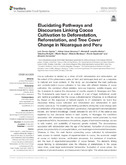Mostrar el registro sencillo del ítem
Elucidating Pathways and Discourses Linking Cocoa Cultivation to Deforestation, Reforestation, and Tree Cover Change in Nicaragua and Peru
| dc.contributor.author | Orozco-Aguilar, Luis | |
| dc.contributor.author | López-Sampson, Arlene | |
| dc.contributor.author | Leandro-Muñoz, Mariela E. | |
| dc.contributor.author | Robiglio, Valentina | |
| dc.contributor.author | Reyes, Martin | |
| dc.contributor.author | Bordeaux, Melanie | |
| dc.contributor.author | Sepúlveda, Norvin | |
| dc.contributor.author | Somarriba, Eduardo | |
| dc.date.accessioned | 2021-06-24T02:32:52Z | |
| dc.date.available | 2021-06-24T02:32:52Z | |
| dc.date.issued | 2021-06-17 | |
| dc.identifier.uri | https://doi.org/10.3389/fsufs.2021.635779 | |
| dc.identifier.uri | https://repositorio.catie.ac.cr/handle/11554/10999 | |
| dc.description.abstract | Cocoa cultivation is labeled as a driver of both deforestation and reforestation, yet the extent of the phenomena varies at farm and landscape level and as a response to national and local contexts. In this study, we documented the main pathways and contexts behind cocoa cultivation in two sites with different histories of cocoa cultivation. We combined official statistics, land-use trajectory, satellite imagery, and the Q-analysis to explore the discourses of country experts in Nicaragua and Peru. The Q-statements were based on an analysis of a set of legal, institutional, social, and technical guidelines that the cocoa cultivation/sector influences or is influenced by. Based on the responses of national experts to 31 statements we found four discourses linking cocoa cultivation and reforestation and deforestation in each country-case study. The enabling and limiting conditions driving tree cover change were a combination of landscape configuration, governance, management/commercialization models, and farmer’s knowledge. Overall, between 60 and 64% of the variance was explained by four discourse factors in each country. In Nicaragua, the conditions associated with reforestation were the cocoa-agroforestry model promoted by local organizations/NGOs, the existence of incentives, degree of technical knowledge, access to safe market, and availability of improved genetic material. The circumstances associated with deforestation were the age of the farmers, fluctuation of cocoa beans prices, low productivity of cocoa plantations, and weak legal environmental frameworks. | es_ES |
| dc.language.iso | en | es_ES |
| dc.relation.ispartof | Frontiers in Sustainable Food Systems | es_ES |
| dc.rights | info:eu-repo/semantics/openAccess | es_ES |
| dc.subject | THEOBROMA CACAO | es_ES |
| dc.subject | DEFORESTACIÓN | es_ES |
| dc.subject | REFORESTACION | es_ES |
| dc.subject | COBERTURA ARBOREA | es_ES |
| dc.subject | CULTIVO | es_ES |
| dc.subject | USOS DEL SUELO | es_ES |
| dc.subject | PAISAJE | es_ES |
| dc.subject | RESTAURACION | es_ES |
| dc.subject | NICARAGUA | es_ES |
| dc.subject | PERÚ | es_ES |
| dc.title | Elucidating Pathways and Discourses Linking Cocoa Cultivation to Deforestation, Reforestation, and Tree Cover Change in Nicaragua and Peru | es_ES |
| dc.type | Artículo | es_ES |


